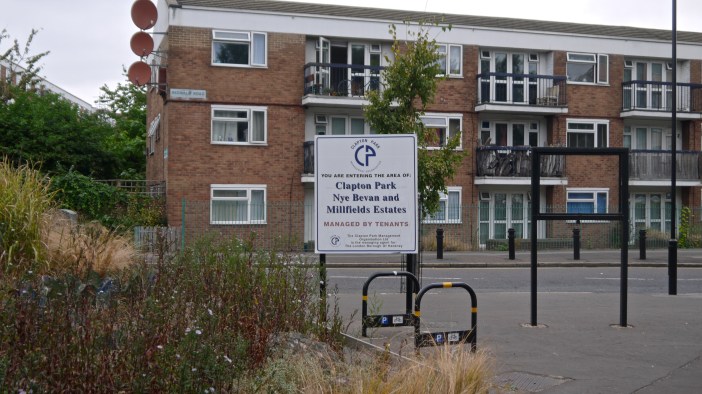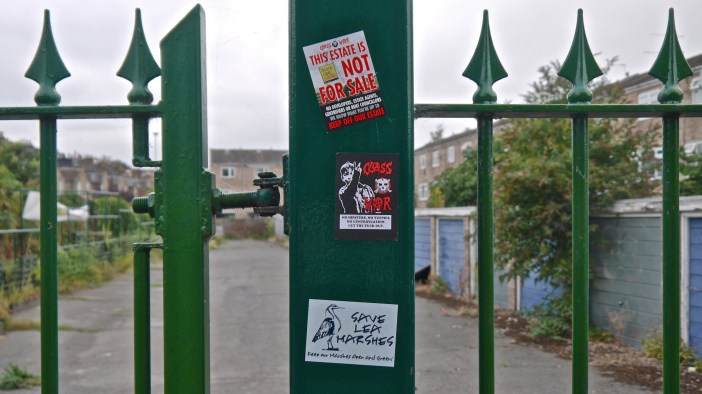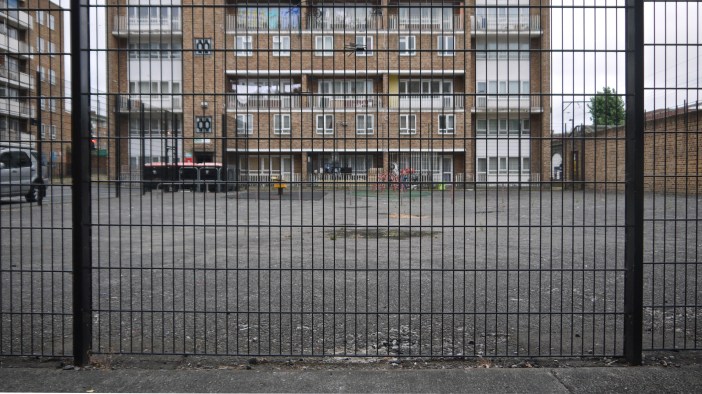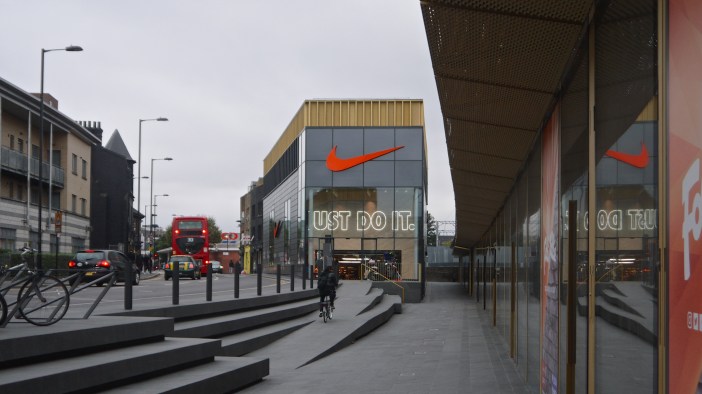On a recent visit around Clapton, ASH was shown some of the tactics being employed by Hackney Labour council to prepare Clapton Park Estate, Nye Bevan Estate, Millfields Estate and Marian Court for the social cleansing of their communities, the demolition of their homes, and the redevelopment of the land for a white, wealthy, middle-class clientele of home buyers. The stories recounted here, the history of the area and the account of what’s going on now, were shared with us by someone who wishes to remain anonymous, but who lives in the neighbourhood, knows the residents, and has fought for the community for many years.

The main access road onto Clapton Park Estate from the south, Daubeney Road has been blocked at the corner of Redwald Road with bollards erected by Hackney council. Ostensibly there to reduce traffic onto the estate, in effect they force residents with cars to make long round journeys whenever they wish to enter or leave their homes.

The struggle to control the roads on the estate is one of the forerunners of the battles to come. Introducing restrictions on parking and raising the price of permits is an effective means of pushing residents out of their own community, while turning the estate into a carpark for the influx of home-buyers in the surrounding neighbourhood.

While homes are neglected of needed maintenance, thousands of pounds are spent on gardening carried out by an outside company working to improve the external appearance of the estate for prospective investors. Behind its happy signs, however, Clapton Estate is run by a Tenant Management Organisation installed by the Labour council, and which completely ignores the wishes of the residents it claims to represent.

The other three council towers built on this model in the area were demolished by the Labour council for being unsafe for habitation, and replaced with mid-rise homes built on the City Villages model currently being exported by Labour council-led estate demolition schemes across Greater London.

The remaining tower, however, given the refurbishment it needed, is now gated private accommodation, complete with palms, security guards and ground-floor infill, and the council flats it once provided are lost forever for the 15,500 people on Hackney council’s waiting list for homes.

This estate is not for sale, but situated between the Lea Valley canal and rapidly gentrifying Clapton – whose main thoroughfare, Chatsworth Road, is lined with estate agents, artisanal bakeries and ethically-sourced coffee shops – it soon will be.

These residents’ garages, like all those on the estate, have been left to fall into disrepair through lack of maintenance by the council, while the land opposite was given a £40,000 grant to be turned into a decorative garden and seating area for the local hipsters and middle-class families. The gardening on the estate is done by an outside company that does not employ local labour or consult with residents on what they would like done to their homes.

Fenced and padlocked against residents’ use, this parking space, now disused, is classified as brownfield land, meaning any developer that proposes a housing development on its land will automatically receive planning permission in principle. Once built, even a smallish block of private homes will attract further investors, assured that the Labour council is docile and accommodating.

More residents’ garages refused maintenance. These too, once closed for health and safety reasons, or when they simply fall into disuse, will become brownfield land. The more areas on the estate are classified as such, the easier it is to draw a red line around the whole thing and call it a ‘Regeneration Area’, within which what few planning restrictions remain after the Housing and Planning Act will disappear.

The Nye Bevan estate, named after the Health and Housing Minister in the post-war Labour Government that founded the NHS and built over 1 million council homes between 1946 and 1951. It’s safe to say that Bevan would be turning in his grave at what the current Labour Party is doing to his legacy.

The secular equivalent of the village church, the Community Hall, built in the 1960s, is located at the centre of the two estates, and should be their heart.

Instead it’s this. To kill a community, the first thing councils do is deprive residents of their communal spaces. The Nye Bevan Hall was closed by Hackney Labour council a year-and-a-half ago, and residents are now forced to travel off the estate to attend meetings with councillors. This effectively rules out attendance by the elderly, those with disabilities or other mobility problems, who return home late from work, who don’t have the travel money to get there, or who have children and other dependents to look after.

Although closed to the community it was built for, the hall can now be booked for private hire at commercial rates that are far beyond the reach of the estate’s residents.

Another after-school venue has been taken away from working mothers who relied on it to look after their children while at work, driving their families into greater poverty and benefit dependency.

The surest way to create an estate’s reputation for crime and anti-social behaviour is to close community venues and access to activities in which the estate’s youth can find collective identity and security away from the street.

Once a symbol of their local identity, the E5 hall and playground is now locked against use by kids from the estate.

The climbing frames removed for so-called ‘health and safety’ reasons by the same gardening company, this now disused children’s playground becomes brownfield land, on which any housing development proposed on this coveted plot, which faces directly onto leafy Clapton Park, will receive planning permission in principle.

One of the few communal spaces left, and therefore a source of community identity, organisation and possible resistance, the local allotments are also under threat by Hackney Labour council, who have already tried once to close them down, but were defeated by strong community opposition.

The community-run boxing club, which needs £50,000 to stay open, has been refused financial support from Hackney Labour council, which has moved the facilities that were based in the closed Nye Bevan Hall directly adjacent, and demanded shared use of the land.

Founded in the 1960s, the club has raised the funds needed to keep itself going from charity events in which professional boxers who trained here as kids return to support their community.

With its strong message of support for local kids, and its offer of a refuge from the lure of gangs, this is the last kind of initiative Hackney Labour council wants to see thriving in a community it is trying its best to kill.

Any role for a black kid beside a Jobseeker’s job search, a road sweeper, a Tesco’s security guard or a Sainsbury’s check-out girl is not encouraged by Hackney Labour council.

Bored kids, by contrast, make good drug dealers, criminals and rioters, confirming the reputation of estates the Labour council wants to demolish. Beside the land it stands on, this is another reason Hackney council wants to shut down this haven for the estate’s youth.

The one garage on the estate that has been maintained belongs to the local vicar, whose rectory, as you can see, is twice the size of the homes of his parishioners.

As in every working-class community, the local church is the voice of middle-class authority, preaching resignation and obedience to its congregation, and refusing to oppose the Labour council that pays its salary.

Under threat of demolition, Marian Court has recently been occupied by Sisters Uncut as a protest against cuts to support for mothers trying to raise their children under increased cuts to benefits, as well as for women trapped by domestic violence.

Another playground removed of its climbing frames, another place fenced off to children, another once-used space reclassified as brownfield land.

Though all council estates, under the Housing and Planning Act, can now be reclassified as brownfield land, the closing of playgrounds and the managed decline of garages are the forerunners of the council’s reclaiming of public land for private sale.

The space for estate parking is now closed to the estate’s residents.

And the garages have been run down into a state of disuse. Backing directly onto the similarly closed playground, an area for new development has effectively been carved from the land residents are living on, and the building site that will soon be here will drive the majority of them away.

The rail arches alongside the estate have been closed, depriving local kids of the chance for apprenticeships and jobs in the businesses that previously served the local community.

The garages, mechanics and other businesses have been evicted from the premises, their leases torn up, and the venues of a formerly thriving local industry closed down.

And, directly opposite, under the same set of arches, replaced with this.

Hackney’s share of the London Riot Regeneration Fund has been spent on the so-called Fashion Hub. Home to Mayfair labels like Gieves & Hawkes and Joseph, these upmarket retail outlets are in a different universe to the needs of the local community, being targeted, instead, at luring the white middle-class families that are colonising the area. While in the new Nike shop, consumption of the mass-produced commodity has replaced employment within local businesses as the model of aspiration for black working-class youth.

A finger of gentrification, a tool in the social cleansing of Hackney, an image of the future of Brixton Arches.

Five years after the riots, this is the model of class and race relations being promoted by the Labour Council in Hackney, London, 2016.
Architects for Social Housing
ASH published this article in September 2016, when it was described by Philip Glanville, the Labour Mayor of Hackney, as ‘the worst thing on housing I’ve ever read’, which all but confirmed our suspicions were right. Since then, the Pedro boxing club is facing closure for lack of funds, and Marian Court has been condemned for demolition and redevelopment to a design by Adam Khan Architects. The current proposal, for which the council is seeking a private developer as partner, is for the demolition of the estate’s 75 council homes and their replacement with 30 ‘social units’ (which may mean for social rent, but could also mean for affordable rent), 60 for shared ownership, and 75 for private sale.

In its consultations with the remaining residents, Hackney Labour council is claiming that only 27 of the estate’s homes were for social rent, and that therefore this redevelopment represents a net increase. But unless the other 48 homes were all owned by leaseholders, which is highly unlikely, this is a product of the council’s policy of driving council tenants out through a lack of maintenance and servicing of their homes, then replacing them with tenants on shorthold tenancies who, when their homes are demolished, do not count toward the total loss of homes for social rent and do not have to be rehoused in the new development. This practice, which in its newsletter to residents of December 2016 Hackney Labour council explained as the temporary use of empty homes to house constituents on its housing waiting list, is just another dirty trick of a dirty council.
To complete the social cleansing of the Marian Court community, Richard Cholquhoun, despite just moving into a shared ownership apartment on the new Brooklime and Chervill Houses, has been installed by Hackney council as the Chair of the newly formed Tenants and Residents Association for Brooklime, Chervill and Marian Court. Cholquhoun, a middle-class white man, has already used the newsletter to lie to residents about the protest by Sisters Uncut, whom he dismissed as ‘squatters’, about what will be built in place of their demolished homes, about where residents will live during redevelopment, and about their right to return to properties they will not be able to afford either to rent or to buy. This, too, is another dirty trick of a dirty council.
As a further update to this article. The seventh photograph in this post shows the deliberately run-down garages on Daubeney Road, directly opposite the entrance to Daubeney Fields, which leads down to the River Lea. We pointed out that while the row of 25 residents’ garages has been deprived of maintenance until they fell into disrepair and were closed, the area opposite had been given a £40,000 grant to be turned into a decorative garden for the recent influx of middle-class families into the neighbourhood. As we predicted, in September 2017 Hackney council announced that Al-Jawd Pike Architects had been appointed to develop designs for around 11 affordable homes on this ‘brownfield’ site – ‘affordable’, in this context, meaning properties for shared ownership through Help to Buy subsidies from the government available to households earning up to £90,000 per annum in London. Philip Glanville, the Mayor of Hackney, describes this development as part of the council’s ‘social housing drive’.

Postscript. On 6 June, 2018, Hackney council’s Planning Sub-Committee granted planning permission for the demolition and redevelopment of Marian Court. Contrary to the figures quoted in the council’s consultation with residents, the planning application clarifies that Marian Court had 47 homes for social rent – not 27 – and 28 leaseholder properties. The new development will now have 32 dwellings for social rent (a reduction of 15 from existing provision), 59 for shared ownership, and 69 for private sale: a total of 160 properties, of which only 20 per cent will be for social rent. As usual, though, the council has argued that, including the homes for shared ownership, which they call ‘intermediate housing’, 56 per cent will be ‘affordable housing’; and that across the masterplan for Marian Court, Bridge House, Brooklime House and Chervill House, 66 per cent will be affordable housing, of which only 35 per cent will be for social rent (meaning 23 per cent of the total). To get an idea of what this means, properties in the completed Brooklime House are currently on sale for £576,000, and in Chervill House for £572,000. This shows, yet again, how meaningless the term ‘affordable housing’ is as a measure of affordability or tenure, and how it is used by councils such as Hackney to reduce the provision of homes for social rent.
Architects for Social Housing is a Community Interest Company (no. 10383452). Although we do occasionally receive minimal fees for our design work, the majority of what we do is unpaid and we have no source of public funding. If you would like to support our work, you can make a donation through PayPal:



Seem the same thing happen with neglected council garage areas in Essex: council refused to maintain them, saying it was the new housing association’s job, nothing happened, rents on garages increased so the estate was filled up with on-street parking, then the garages were sold a built on as private rents. Familiar?
LikeLike
A similar thing is happening at Lincoln Court in Stamford Hill, Hackney N16, where there are single storey garages that have play decks on the top which were designed to provide the majority of the open and play space for the 198 households on the estate.
Hackney have withheld money from the maintenance of the garages over a number of years to the detriment of the structures, in spite of written committments made to the residents. In 2013 they quietly stopped people applying for parking spaces in the garages in order to depress the number of people using the garages, and where people have let there parking leases lapse by even a month they have not been allowed to renew. Then in 2014 they commissioned a feasibility study regarding possible sites for new housing on existing estates in the borough, for which they neglected to tell the consultant about the necessary open and play space that these structures provide for existing residents. No prizes for guessing the outcome of the feasibility study – the consultant recommended Lincoln Court should be included in the council’s Housing Supply Programme.
When they susbesquently presented the proposals for the Housing Supply Programme to Hackney Cabinet, including Lincoln Court as a probable site, for an approval vote, they made a committment to the Cabinet that ‘there will be no loss of play space…’, but neglected to say that the Lincoln Court proposals would lead to loss of almost all the currently designated play space. And who was the Cabinet Member for Housing presenting this to Hackney Cabinet… step forward Philip Glanville (now Hackney Major).
Now Lincoln Court residents are trying to push back against the council on the basis that the existing residents would be left with second class housing provision if the HSP proposals go ahead as proposed, but Hackney don’t care because they are focussed on the PR and financial benefits of building the additional houses. They keep telling us that we need to understand that they have to strike a balance and that on balance the new housing is more important, but when we asked them whether they had assessed the needs of the existing residents in order to weigh them against the need for new housing, they admitted that they haven’t even considered the needs of the existing residents.The phrase ‘institutional indifference’ seems strangely apt.
LikeLike